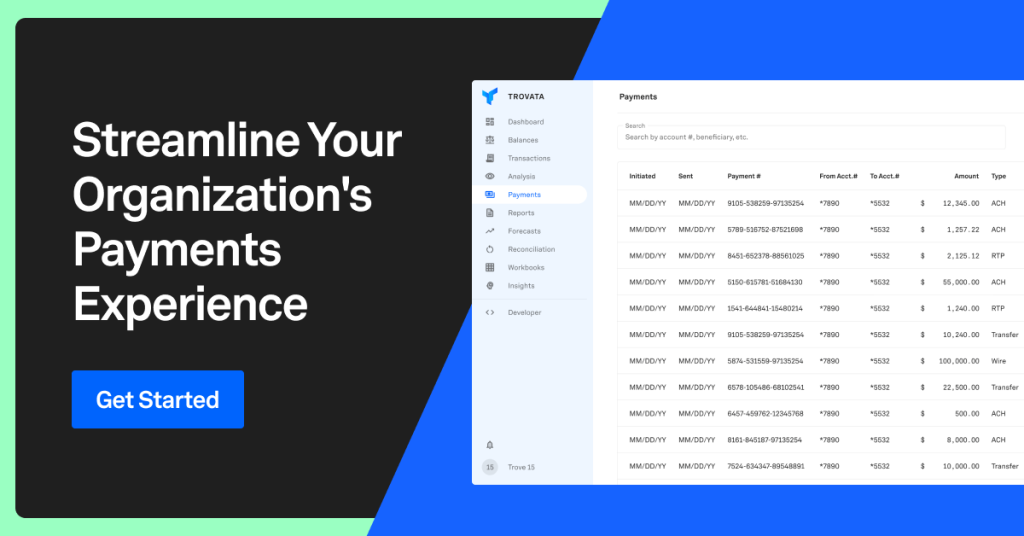For all the advances in treasury technology, corporate payments can still be a major headache. Many organizations still track and process their payments directly through their banking institutions. If they have multiple accounts, that means logging into each bank portal, keeping a manual log of upcoming payments in spreadsheets, and ensuring they have the funds necessary to pay their vendors on time.
It’s not only an inefficient use of valuable time, it also creates many opportunities for errors or missed payments. This can impact relationships with vendors, but it can also lead to inaccuracies in financial reporting and forecasting.
Something that should be a relatively straightforward component of treasury operations, can easily turn into a major source of frustration and risk. That is, unless technology is used to make it easier and more efficient. The right solution centralizes payments in treasury management
But not all tech is created equal. It’s easy to add new software platforms for every part of the finance and treasury process, including payments. However, that can quickly create a complicated maze of a tech stack that makes training, management, and future change far more challenging.
That’s why it makes sense to integrate a multi-service treasury platform that can automate bank data aggregation, offer powerful data analytics, and manage payments, all in one place.
Let’s take a look at why you should consider simplifying your payments process, and how to do it.

The 3 Main Ways to Manage Corporate Payments
There are a range of ways to manage corporate payments, and the right option will depend on the size of the organization and the existing technology being used.
Manual Payment Processing
Here, we’re talking about keeping a list of accounts payable, which are then filled by staff manually logging into their banking portals, making the payments and noting the payment as made on the list.
This could be manually reconciled using a spreadsheet, or through accounting software. For most small businesses, this is the way payments are managed, and it makes sense. Manual processes keep costs low and allow very close monitoring of where payments are going.
But as a company scales, this process becomes inefficient and time consuming. A task that previously took a few hours a week to complete may now take 20-30+ hours a week. This is especially true as the number of accounts grows, requiring teams to track and make payments through multiple banking portals.
Dedicated Payments Software
When payments volume becomes too large for manual processes, many companies look for a dedicated payments solution. This comes with significant benefits, including total or partial automation of the payments process, the ability to make payments from multiple bank accounts in one place, and enhanced tracking and analytics.
It saves time and improves the data gathered through the payments process. But it doesn’t come without downsides.
There are fees involved with any new software, and for enterprise level companies these fees can be significant. The new technology also requires an implementation period, with initial and ongoing training with staff to ensure they understand how to use the software effectively. It also increases the time it takes to onboard new staff, and adds to the company’s technical debt over time.
Treasury Software with Payments Capabilities
The third option is to combine all of your treasury tech needs into a single platform. Rather than having separate software for cash management, payments, accounts receivable, invoicing, expense tracking, and everything else, treasury and finance teams can use an all-in-one platform that provides the functionality to do all of those things.
This keeps costs low, as a single fee covers all of the requirements, rather than individual costs for each feature. And it simplifies the training and operations process, as there is only one platform for staff to learn.
It also consolidates and normalizes all of your financial data in one place. This makes reporting and financial forecasting easier, more accurate and faster.
Technical support becomes far simpler, too. Instead of having to raise tickets with multiple companies or request features in a dozen different ways, a consolidated approach allows for a closer working relationship with the treasury technology provider.
Having a single source of truth for all your banking and payments data offers all of the benefits of a dedicated payments platform (and more), without any of the downsides.
Don’t Overcomplicate Your Tech Stack
Before we look closer at the benefits of using an all-in-one treasury platform to manage payments, let’s talk about tech stacks.
The term itself conjures up images of a big pile of different platforms, all super specialized to their dedicated task. It’s been a widely used term in software engineering for a long time, and it’s becoming more common in finance and treasury.
But a deep and complex tech stack isn’t necessarily a good thing. There are some significant downsides to taking this approach.
Cost
As mentioned above, the fees on these individual platforms can scale quickly as new software is added. Just like our personal subscriptions to Spotify, Apple TV, Netflix, Disney+ etc. all look reasonable in isolation, it doesn’t take long before the combined cost is putting a major hole in our household budget.
It’s the same for corporate software.
Training and Management
The more platforms that are added to your tech stack, the more training and ongoing account management is needed. With so many different software in play, the update cycle will be highly regular, as each platform pushes out their own updates on their own schedule.
This drops the efficiency of your team, and makes the onboarding process for new hires far more complicated.
Technical Debt
As the software becomes integrated into the treasury tech stack, it also introduces technical debt that makes future change more challenging. Essentially, the more software platforms that are added and customized, and the more complex the tech stack becomes, the harder it is to make changes without breaking something in the workflow.
How Trovata Simplifies Payments: 7 Tools for Success
Trovata is the modern, all-in-one treasury platform which gives finance and treasury teams everything they need to manage payments more efficiently. Not only that, but the comprehensive suite of tools and features offers advanced capabilities in reporting, forecasting, cash management and more.
Here are the key ways Trovata enhances payment management:
1. Seamless Integration with Bank APIs
Trovata leverages direct connections with bank APIs. This integration allows for access to 100% accurate, real-time financial data, and payment processing, all in one place. Additionally, API’s give you the ability to make real-time payments (RTP), and is the only way for you to gain access to RTP.
This helps to future proof your organization. A recent survey from US Bank, encompassing over 2000 senior finance leaders, found that 51% of businesses are currently using instant payments and 80% plan to use them by 2026. This isn’t surprising given the mutual benefits RTP provides for both sides of the transaction. Rather than the usual one to two days for a standard ACH transaction or longer for other methods like checks, from a settlement standpoint, RTP saves both sides time and expense compared to more traditional payment methods.
But Trovata’s multi-bank connectivity isn’t limited to APIs.

Trovata has become the global standard for bank connectivity, combining API connections with the ability to collect and normalize data across legacy file formats and transfer methods, such as SWIFT, BAI and ISO 20022. This delivers standardized data, opening up big opportunities for forecasting and data analytics.

2. Comprehensive Payments Dashboard
The payments dashboard in Trovata provides a centralized view of all your payment activities, eliminating the need to login to multiple banking portals. You can easily track the status of each payment, view detailed information, and manage your entire payments workflow from a single interface.

The dashboard includes features like:
- Filtering and Searching – Quickly find specific payments using Trovata’s natural language search or by applying various filters such as date range, payment type, and status.
- Detailed Payment Information – View complete details of each payment, including initiation date, payment ID, account number, payment type, and beneficiary information.
3. Flexible Payment Initiation Options
Trovata offers three methods to initiate payments, catering to different business needs:
1. Manual Payments – Initiate payments manually, similar to traditional bank portals, with options to schedule payments for future dates.
2. Payment Templates – Use pre-configured templates to streamline recurring payments, saving time and reducing errors.
3. Bulk Payments – Upload CSV files to process multiple payments simultaneously, supporting various banks and payment types. Bulk payments ensure that individual transactions are processed separately, minimizing the risk of total batch failure.
4. Enhanced Cash Management
Payments aren’t the only way a treasury needs to move money. Efficient movement of cash can reduce risk and increase yield, as long as it can be done quickly and efficiently.
Trovata allows you to orchestrate money movement efficiently by initiating Real-Time Payments (RTP), ACH, and wire transfers all within one platform.

This eliminates the need for third-party processors and the hassle of logging into multiple bank portals, making cash management and payments far simpler.
5. Customizable Payment Workflows
Payment workflows in Trovata are highly customizable, allowing you to design processes that fit your organization’s specific needs. Workflows can include multiple stages for review and approval, with custom rules to enhance security and compliance.
Some of these key features include the ability to assign workflows for specific bank accounts, defining user roles and permissions, and setting automatic approval rules based on criteria such as high-value transactions.
6. Real-Time Payment Tracking
With Trovata, you can monitor the progress of your payments in real-time. The platform provides updates from the banks, allowing you to track each payment from initiation to completion, all in one place. This transparency helps in identifying and resolving any issues fast, ensuring that your payments are always on track.

7. Powerful Data Analytical Tools
Trovata doesn’t just streamline payments, it unlocks analytics and insights based on your payments data. These tools allow you to analyze payment data, uncover trends, and make informed decisions. The AI-powered reporting features provide deep insights into your payment processes, helping you optimize and improve your financial operations.
Your Treasury One Stop Shop
Handling payments efficiently and accurately is a cornerstone of the finance and treasury teams operations. While dedicated payments platforms offer a lot of benefits, they come with some serious drawbacks in the form of increased complexity, cost, ongoing training needs and technical debt.
Trovata’s all-in-one treasury platform revolutionizes the way businesses handle payments, while simplifying your tech stack. By integrating bank APIs, offering a comprehensive dashboard, and providing customizable workflows and user permissions, Trovata simplifies and secures the payment process.

The platform’s ability to handle manual, template, and bulk payments, combined with real-time tracking, makes it a valuable tool for any finance or treasury team.
Want to learn more? Download our Trovata Payment product overview for all the details.




